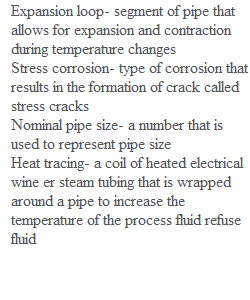


Q Process Technology Equipment Ch. 4 Test A. Expansion Loop B. Stress corrosion C. Nominal pipe size D. Heat tracing E. Corrosion F. Gasket G. Pipe shoe H. Steam trap I. Tensile strength J. MAWP K. jacketed pipe L. Pipe hanger M. Insulation N. Alloy O. Schedule P. Blind Q. Pipe clamp 1.___-compounds composed of two or more metals or a metal and nonmetal(e.g. carbon steel) that are mixed together in a molten solution 2.___- solid plates or covers that are installed between pipe flanges prevent the flow of fluids and to isolate equipment o piping sections when repairs are being performed; typically made of metal 3.__-deterioration of a metal is a chemical reaction (e.g iron rusting) 4.__segment of pipe that allows for expansion and contraction during temperature changes 5.__-the pulls in one permit area and to break a given specimen 6.__flexible material used to seal components together so they are air or watertight. 7.__a coil of heated electric wine er steam tubing that is wrapped around a pipe to increase the temperature of the process fluid, reduce fluid viscosity an facilitate flow 8.__any substance that prevents the passage of heat, light, electricity, or sound from one medium to another 9.__a pipe within a pipe design that allows hot or cold fluids to be circulated around the process fluid without the two fluids coming into direct contact with each other 10.__maximum allowable working pressure a safety limit for components in Piping system: the safe pressure level determined by the weakest element in the system. 11.__-a number that is used to represent pipe size 12.__piping support that protects piping, tubing, and hoses from vibration and shocks also a ring-hype device used to stop a pipe leak temporarily. 13.__-piping support that suspends pipes from the ceiling or other pipes. 14.__piping support that supports pipes from beneath. 15.__piping reference number that pertains to the wall thickness, which affects the inside diameter (ID) and specific weight per foot of pipe. 16.__device used to remove condensate from the steam system or piping. 17.__-type of corrosion that results in the formation of cracks (called stress cracks). Check Your Knowledge 18. Which of the following is the primary material for piping a. Carbon steel b. Plastic lined material c. Solid plastic d. glass 19. A type of support that suspends pipe from the ceiling is a(n): a. Pipe clamp b. Pipe hanger c. Pipe shoe d. Expansion loop 20. (True or False) Caps can be threaded, glued, or welded. 21. Carbon steel can be used in which of the following Fahrenheit temperature ranges? a. -50°F to 450°F b. -150°F to > 1400°F c. -20°F to 800°F d. -60°F to 600°F 22. Which of the following is NOT a material used for piping insulation? a. Plastic b. Fiberglass c. glass d. Rigid foam 23.______might be an indication that the sealant compound or tape was not applied correctly. 24. Which of the following is a white tape-like substance used to lubricate the thread connections of a male pipe thread? a. Pipe dope b. Oil c. Sealant compound d. Teflon® tape 25. Which of the following tests are used to perform a pressure tightness test on a piping system? (Select all that apply.) a. Hydrostatic testing b. Pneumatic testing c. Temperature testing d. Hypertesting PreviousNext
View Related Questions